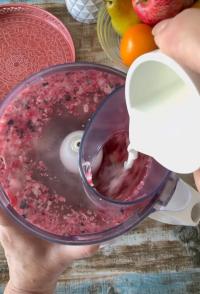Copy Link
Add to Bookmark
Report
Mead Lovers Digest #0998

From: mead-request@talisman.com
Errors-To: mead-errors@talisman.com
Reply-To: mead@talisman.com
To: mead-list@talisman.com
Subject: Mead Lover's Digest #998, 5 March 2003
Mead Lover's Digest #998 5 March 2003
Forum for Discussion of Mead Making and Consuming
Dick Dunn, Digest Janitor
Contents:
Eucalyptus honey (Tom Smit)
Newbie questions on Tart cherry mead ("Kristopher Barrett")
("Aaron Ardle")
Mead Summary from MLD - Rules of making Mead (jlparkinson)
Re: Newbie questions on Tart cherry mead ("Randy Goldberg MD")
Re: Gas Laws and CO2 purging ("Randy Goldberg MD")
Aging "turpentine" ("Geoffrey T. Falk")
1st timer (devilscandy17@netscape.net)
NOTE: Digest appears when there is enough material to send one.
Send ONLY articles for the digest to mead@talisman.com.
Use mead-request@talisman.com for [un]subscribe/admin requests.
Digest archives and FAQ are available at www.talisman.com/mead. There is
a searchable MLD archive at hubris.engin.umich.edu/Beer/Threads/Mead
----------------------------------------------------------------------
Subject: Eucalyptus honey
From: Tom Smit <lunica@ozemail.com.au>
Date: Sat, 01 Mar 2003 09:55:26 +0900
Scotty wrote:
> Sorry but I would have to dissagree. Can you let us know what sort of
> Eucalyptus honey your using. (Iron Bark, Mellalucca etc) Eucalyptus ranges
> from as pitch black as dark malt extract and as light as 3 EBC pils malt.
> To reject wholesale all Euco honey is like saying all malt is bad!
> Even as dark as the honey gets I have never tasted a "euco" flavour in any
> euco honey. I am a compulsive Euco candy eater and know the taste well.
> If Euco honey tastes bad in your mead would it not taste like crap on your
> toast as well?
Never thought I would ever agree with Scotty!
I have used eucalyptus honey in beers and mead and never tasted a eucalyptus
flavor.
Wonder if the people that do are using fresh honey? Maybe it is psychosomatic?
so yes more details of the honey where you bought it how old it was blah blah
Tom Smit
------------------------------
Subject: Newbie questions on Tart cherry mead
From: "Kristopher Barrett" <kbarrett@cotse.com>
Date: Fri, 28 Feb 2003 18:25:24 -0500 (EST)
> Questions:
> 1. Are Campden tablets needed to prevent bacteria growth or will the
> storage temp and alcohol content keep the brew safe?
At 24 proof, nothing but yeast is going to survive in there. Don't worry
about it.
> 2. How long can I keep the brew in the secondary before running the
> risk of autolysis? Does this risk exist with champagne yeast? Is there
> any advantage to aging in the glass carboy over bottles?
If you rack off of the sediment, then you can let the meade age
indefinately. The longer, the better.
Carboys are easier to rack sediment off of. Age them in the carboy until
the meade is at least clear. You might end up with a still meade, but the
product will taste better.
> 3. When transferring to the secondary, the esters were MUCH stronger
> than anything I have experienced when doing beer brewing and the
> tartness of the cherries was quite pronounced. The cherry aroma was
> spot-on, but I was hoping for sweeter cherry flavor. Will the esters
> mellow over time? Should I consider using Splenda or some other
> sweetener to address the tartness? Is the ester intensity the result of
> the Red Star champagne yeast? If so, in the future should I consider a
> Wyeast wine yeast or beer yeast and expect lower alcohol content, but
> lower esters?
Let it age a bit.... the esters will mellow out. I have been using a mix
of Red Star and Lalvin champagne yeast for quite a while, and have had no
problems with the end result.
If the meade is too tart, add some calcium carbonate to get the PH down to
reasonable levels. Don't sweeeten unless you are specifically trying for a
sweet meade.
> 4. What is the best secondary sugar for bottle carbonation with mead?
> I've used 1 cup corn sugar per 5 gallons for beer with great success,
> but am unsure for mead.
More honey. About a cup disolved in hot water and allowed to cool works
well. Often too well.
> 5. Should I consider a third racking for clarity? To date, there is not
> quite an inch of bottom sediment and the mead is not crystal clear, but
> getting there. Is it unreasonable to expect the mead to be clear on its
> own by December 2003?
Racking is good. Rack now. I will rack once every three or four weeks
until the sediment is down to a fraction of an inch.
- --
Regards,
Kristopher Barrett http://www.cotse.net/users/kbarrett
------------------------------
Subject:
From: "Aaron Ardle" <aardle@columbus.rr.com>
Date: Sat, 1 Mar 2003 20:31:27 -0500
What is the UF method? or maybe it's the UM method, the point is I've =
heard it mentioned but the people who were talking about it already knew =
what it was.
also,
what would a dandelion mead be called?
thanks!
aaron
------------------------------
Subject: Mead Summary from MLD - Rules of making Mead
From: jlparkinson <jlparkinson@telstra.com>
Date: Mon, 03 Mar 2003 09:31:04 +1000
With MLD #1000 almost upon us, and as a tribute to the many
and varied contributions that have been made over the years,
the following light-hearted summary is my thank-you for the
hard work and combined knowledge that is the MLD.
(Please take this in the spirit it was written :) - from a newbie)
- -=-=-=-=-=-=-=-=-=-=-=-=-=-=-=-=-=-=-=-=-
Rules of Meading
1: There are no rules :)
It is an art, not a science, due to the variable nature of
the various components that make up the process. However,
repeatability of results is obtained by being "scientific"
(document, measure, ...).
2: Sanitisation is vital.
Avoiding wild yeast and bacteria will reduce bad odours
and off-flavours.
2: Patience is mandatory.
There are ways of improving the speed from pitching to bottling,
but the slow way usually produces the *premium* product.
Obviously, we would all be more patient IF IT DIDN'T TAKE SOOOO
LONG :)
3: Never throw out a batch.
If leaving the mead for three years does not improve the falvour,
then mix it with other mead, use it as the basis for a mixer,
turn it into vinegar, or ...
If in doubt, re-evaluate the mead in a years time ;)
4: For every method (of making mead), there is an equal and opposite
method (and more vocally espoused?) .
* You should pasteurise the must, unless you boil it, but some just
add the honey as it is (but still try to enforce rule 2 by being
as "clean" as possible).
* You shouldn't use bread yeast - unless you do.
* You can add sulphite and sorbate to stop/inhibit the ferment, but
many don't.
* You can use finings (bentonite, irish moss, isinglass, sparkolloid,
gelatin, egg white, ...), and it usually helps to have tannin in
the must especially if the fining is based on albumin.
Also refrigeration will help to settle out suspensions. Filtering
is also an option, but could possibly reduce colour and flavour.
* You definitely rack off the lees to avoid autolysis of the
yeast(but Brother Adam leaves his mead in Sherry oak casks on the
lees - for many years. Others have forgotten, and left their mead
to age on the lees to good effect)
* An air lock should be used to eliminate oxygen and contamination
from the ongoing ferment, but in old days, they just covered their
jugs with a cloth (who knows if it tasted as good :)
* You should make a yeast starter, but many just pitch the yeast
straight into the must.
* You can add the fruit to the primary (directly, or in bags), but
others swear that adding it to the secondary provides better
aroma/flavour.
* Avoid boiling which reduces the aroma/flavour, but many achieve
great meads via boiling.
* Ferment using a bucket as the primary fermenter (especially if
fruit in the must), unless you use a carboy as the primary.
* Eliminate all chances of oxygenation (not including the oxygenation
at yeast pitching), however a little oxygen is required for long-
term maturation to break down higher alcohols (hence casks - which
breathe and lose alcohol over time).
* Measure the specific gravity at the start (OG) and at the finish
(FG), and to determine when fermentation has stopped - but you
don't have to.
* Measure and adjust the acidity (improve the flavour before bottling)
- but you don't have to.
* Top off your carboy with each racking - but some leave the head-
space
alone and have no problems (and don't change the concentration of
flavours due to addition of must). And some fill the head-space
with CO2.
* Maintain the temperature at just under a comfortable room
temperature for fermentation for most yeasts - but one french
meadery (Mercier) ferments at much higher temperatures (and
ages in oak)
* You can stop the ferment via many ways (chill, sulphite/sorbate,
pasteurise, feed until the yeast is drops out) - but leaving it
to finish in its own good time will also work.
* The primary can be plastic or glass, but *always* use glass as the
secondary (I'm waiting for the exception of this one to be found :)
5: Relax and have another homebrew.
6: Quote Yoda
"No...Try not! Do...or do not! There is no try." (Yoda, Jedi Master)
7: Refer to rule 1
regards,
James
- --------------------------
You knead dough,
You mead honey,
You need to do another batch of mead.
- --------------------------
------------------------------
Subject: Re: Newbie questions on Tart cherry mead
From: "Randy Goldberg MD" <goldbergr1@cox.net>
Date: Mon, 3 Mar 2003 08:07:05 -0500
> 1. Are Campden tablets needed to prevent bacteria growth or will the storage
> temp and alcohol content keep the brew safe?
Campden tablets are sulfites and are not obligatory. You will find, I think,
about a 50/50 split on using them. I avoid them, myself, since many of my
consumers are allergic.
> 3. When transferring to the secondary, the esters were MUCH stronger than
> anything I have experienced when doing beer brewing and the tartness of the
> cherries was quite pronounced. The cherry aroma was spot-on, but I was
> hoping for sweeter cherry flavor. Will the esters mellow over time? Should
> I consider using Splenda or some other sweetener to address the tartness?
> Is the ester intensity the result of the Red Star champagne yeast? If so,
> in the future should I consider a Wyeast wine yeast or beer yeast and expect
> lower alcohol content, but lower esters?
Many of us have found that putting fruit in the primary loses much of the
fruit character. I'm planning on putting fruit into the secondary on my next
batch. Also, 2-3 lbs of fresh fruit per gallon of mead seems to be the rule
of thumb - 6 lbs in 5 gallons is very light on the fruit, unless you're
using dried fruit. I personally have not had success with Wyeast brand, and
don't recommend it, YMMV.
> 4. What is the best secondary sugar for bottle carbonation with mead? I've
> used 1 cup corn sugar per 5 gallons for beer with great success, but am
> unsure for mead.
I use more honey.
> 5. Should I consider a third racking for clarity? To date, there is not
> quite an inch of bottom sediment and the mead is not crystal clear, but
> getting there. Is it unreasonable to expect the mead to be clear on its own
> by December 2003?
Yes, and no. I have racked up to 5 times. You can also just wait. Chilling
may also help with the clarity.
Randy
****************************************
RandomTag: There is never truth without sufficient proof.
------------------------------
Subject: Re: Gas Laws and CO2 purging
From: "Randy Goldberg MD" <goldbergr1@cox.net>
Date: Mon, 3 Mar 2003 08:09:48 -0500
> I thought the Gas Laws [Graham's Law I think, but I am
> not sure, and think there is another one involved as
> well] stated that Gases naturally mixed [Diffusion or
> Effusion] according to their relative densities in a
> particular space.
>
> Thus if you filled the carboy with a high density of
> CO2 immediately after you stopped the pressure, the
> CO2 would move to the gas volume with a lower CO2
> density and the other air gases would immediately go
> into the carboy where their densities are lower.
>
> Does not this apply to this situation, or is it that
> the diffusion is too slow to worry about?
Yes, once you stop the flow of CO2 into the carboy, it will begin to diffuse
out into the atmosphere if you do not stop up the bottle. However, being a
larger, heavier molecule, CO2 is slower moving than O2 or N2, which affects
the rate of diffusion. As long as you rack your must/wort into the carboy
within a reasonable amount of time (a few minutes?), the amount of O2 in the
bottle will be minimal.
Randy
****************************************
RandomTag: It is better to have the Pope's ear than the King's crown. (If
you want to effect real change in the SCA, work with the system. The crown
will change within 6 months.) - Steffan ap Kennydd, "Silverwing's Laws"
------------------------------
Subject: Aging "turpentine"
From: "Geoffrey T. Falk" <gtf@cirp.org>
Date: Mon, 3 Mar 2003 17:51:47 -0700 (MST)
Hi,
In the past I have heard reports of mead that tasted like turpentine,
that after aging became drinkable. Last August I made a 1-gallon batch
of cyser using LV-1118 Champagne yeast. Last time I sampled a bottle, it
was absolutely undrinkable and I had to pour it out.
This is the first time I've used LV-1118 for mead. It must produce a lot
more phenolics than some others. I have used LV-1122 and ICV-D47 in the
past with excellent results.
Anyways, how long should I expect to wait before popping another bottle
of the cyser? With only a 1-gallon batch, I wouldn't like to waste any.
It is about 14%, still and dry, in 341ml beer bottles with crown caps.
Thanks
Geoffrey
------------------------------
Subject: 1st timer
From: devilscandy17@netscape.net
Date: Tue, 04 Mar 2003 14:53:17 -0500
I have a few questions about making mead I would appriciate any assistance
that can be given. I made my first batch about Feb 10th the receipe states
to bottle when clear. My question is any approximate time that could be
its a berry melomel very deep red at this time. Also what is the perfect
temp to store the melomel at while its in the 2nd stage of fermentation?
Thanks
barnes
------------------------------
End of Mead Lover's Digest #998
*******************************




























